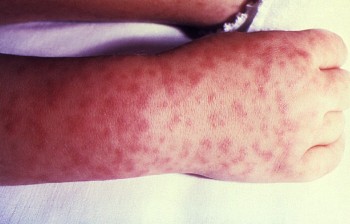Mexicali reports nearly a dozen Rocky Mountain spotted fever deaths this year
The Department of Epidemiology at the Secretariat of Health in Mexicali, Baja California state, Mexico are reporting 11 fatalities from the tick borne disease, Rocky Mountain spotted fever (RMSF), during the first six months of 2014, according to a Uniradio Informa report (computer translated).

Characteristic spotted rash of Rocky Mountain spotted fever/CDC
In fact, since 2009, health officials report 72 deaths due to the lethal rickettsial bacterium. Specifically the report notes, in 2009, 9 people were killed. By 2010 the figure reached nearly 12 deaths; there were 8 in 2011, 15 in 2012, and up to 15 Nov 2013 there were 17 deaths, which, added to the registered in 2014, reach 72 people who were killed by the disease spread by a tick bite.
Last week, Imperial County (CA) health officials reported the first case/death from RMSF.
RMSF is a tick borne disease caused by the organism, Rickettsia rickettsii. Typically, the progress of the disease is a sudden onset of high fever, deep muscle pain, severe headache and chills. A rash usually appears on the extremities within 5 days then soon spreads to palms and soles and then rapidly to the trunk.
Fatalities can be seen in greater than 20% of untreated cases. Death is uncommon with prompt recognition and treatment. Still approximately 3-5% of cases seen in the U.S. are fatal. The absence or delayed appearance of the typical rash or the failure to recognize it, especially in dark-skinned people cause a delay in diagnosis and increased fatalities.
Early stages of RMSF can be confused with erlichiosis, meningococcal meningitis and enteroviral infection.
Related: Tickborne diseases: It’s not just Lyme disease
The organism is maintained in nature in ticks. It can be transmitted to dogs and other mammals, but most times these cases cause little illness. People usually get infected from an infected tick bite. The tick requires from several hours to 24 hours of attachment and feeding to become infectious to people. So prompt removal of the tick can prevent infection. It is not transmitted person to person.
RMSF can be diagnosed in the laboratory using serological techniques, PCR or culture; however because of the necessity of prompt treatment, diagnosis is based on symptoms. There is no vaccine available for RMSF. It can be treated with tetracyclines either orally or intravenously.
Prevention is through immediate removal of ticks, wearing clothes that cover skin and removing ticks from dogs. For more infectious disease news and information, visit and “like” the Infectious Disease News Facebook page















[…] RMSF is a tick borne disease caused by the organism, Rickettsia rickettsii. Typically, the progress of the disease is a sudden onset of high fever, deep muscle pain, severe headache and chills. A rash usually appears on the extremities within 5 days then soon spreads to palms and soles and then rapidly to the trunk. Fatalities can be seen in greater than 20% of untreated cases. Death is uncommon with prompt recognition and treatment. Still approximately 3-5% of cases seen in the U.S. are fatal. The absence or delayed appearance of the typical rash or the failure to recognize it, especially in dark-skinned people cause a delay in diagnosis and increased fatalities. Early stages of RMSF can be confused with erlichiosis, meningococcal meningitis and enteroviral infection. – For complete article see http://www.theglobaldispatch.com/mexicali-reports-nearly-a-dozen-rocky-mountain-spotted-fever-deaths… […]